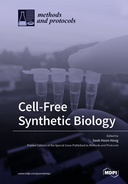Explore

Cell-free synthetic biology is in the spotlight as a powerful and rapid approach to characterize and engineer natural biological systems. The open nature of cell-free platforms brings an unprecedented level of control and freedom for design compared to in vivo systems. This versatile engineering toolkit is used for debugging biological networks, constructing artificial cells, screening protein library, prototyping genetic circuits, developing new drugs, producing metabolites, and synthesizing complex proteins including therapeutic proteins, toxic proteins, and novel proteins containing non-standard (unnatural) amino acids. The book consists of a series of reviews, protocols, benchmarks, and research articles describing the current development and applications of cell-free synthetic biology in diverse areas.
This book is included in DOAB.
Why read this book? Have your say.
You must be logged in to comment.
Rights Information
Are you the author or publisher of this work? If so, you can claim it as yours by registering as an Unglue.it rights holder.Downloads
This work has been downloaded 303 times via unglue.it ebook links.
- 293 - pdf (CC BY-NC-ND) at Unglue.it.
Keywords
- antimicrobials
- artificial cell
- bioconversion platform
- cell-free metabolic engineering
- cell-free metabolic engineering (CFME)
- cell-free protein expression (CFPE)
- cell-free protein synthesis
- cell-free protein synthesis (CFPS)
- cell-free synthetic biology
- cell-free transcription-translation
- CFPS
- chaperones
- colicins
- DNA origami
- Drug development
- E. coli crude extract preparation
- Enzymes
- eukaryotic lysates
- genomically engineered E. coli
- Growth factors
- in vitro protein synthesis
- in vitro transcription-translation (TX-TL)
- in vitro translation
- ischemic stroke
- Mathematical model
- microsomes
- n/a
- protein production
- rapid prototyping
- riboregulator
- sonication
- Synthetic Biology
- tissue plasminogen activator
- TPA
- unnatural amino acid
- unnatural protein
Links
DOI: 10.3390/books978-3-03928-023-0Editions


